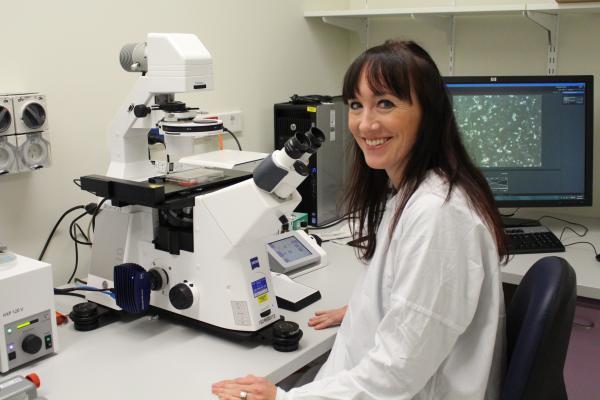
Associate Professor Rachel Conyers is a paediatric, adolescent and young adult malignant haematologist oncologist, meaning she looks at how cancer effects the blood of young people and children.
In 2016, she was awarded a Clinician Scientist Fellowship at Murdoch Children’s Research Institute, where she is currently working on a research project that aims to unlock the reasons why a chemotherapeutic drug class, known as anthracyclines, has a devastating effect on the heart cells of around seven per cent of patients.
Straight to the heart
Anthracyclines are used to treat more than 70 per cent of childhood and adolescent cancers and have significantly improved survival rates. However, for reasons Rachel is aiming to uncover, they can also switch off, and ultimately kill, heart cells.
Read more: Understanding The Genetic Basis Of Chemotherapy-Induced Cardiomyopathy
Rachel recalls examples of when patients who have otherwise been well at the completion of therapy, developed significant heart complications, some even having life-threatening events.
“Those moments have stuck with me,” says Rachel. “I’m driven to find better solutions so these kids can have better outcomes.”
“What I'm looking for in my research are ways to identify those patients with a propensity for cardiac-types of side effects,” explains Rachel.
“Are there genetic components that make some more likely to get these heart complications? If we can identify the children at risk, we can either not give them the drug, or give them a protective medication.”
As part of her research, Rachel has conducted a retrospective study of 300 former patients at two of Melbourne’s leading paediatric medical institutions - The Royal Children’s Hospital and Monash Children’s Hospital. Most had acute lymphoblastic leukemia and small number suffered other cancers, such as bone sarcomas. This has now broadened to a national study involving over 13 adult and paediatric institutes.
Research into action
The Kids’ Cancer Project began funding Rachel’s research in 2018. She says it came at a crucial time.
“We were completely out of funding and had just made a discovery of the genes we want to verify,” she says. “With funding from The Kids’ Cancer Project we’ve been able to progress and expand our initial research.”
Rachel says that because kids’ cancer survival rates have improved dramatically in recent decades, attention is now turning towards minimising long-term side effects of childhood cancer treatments.
Rachel’s research focuses on cardiomyopathy, a condition that occurs when the heart cannot pump blood efficiently, often causing sufferers to require a heart transplant.
Genetic analysis
The recently created Australian Cardio Oncology Registry and Biobank (ACOR) founded by Associate Professor Conyers and Associate Professor Elliott, has several arms to its study.
It includes genetic and radiology investigations, with a proposal for centralisation of cardio-oncology clinics and health economics analysis.
“The aim is to have three centralised clinics around the country so patients can go to specialised multi-disciplinary clinics– that way we can see if centralisation of care leads to better patient outcomes, and also patients all having access to the same research trials,” says Rachel.
Rachael says that funding from The Kids’ Cancer Project has provided enough money to complete the genomic analysis of trial participants.
“Genomic analysis is the expensive part,” she says. “This funding has been critical. Our original [clinical trial] cohort was 16 patients but now we’ve been able to screen 70 patients and have been able to identify eight genes we think are predisposing them to chemotherapy-induced cardiomyopathy.”
“We definitely need more numbers to make this a robust study, but Covid-19 has stymied our ability to recruit patients for the study.”
“What’s happened with the pandemic is that only essential studies have been able to progress, meaning many other studies have been put on hold, but we’re confident our work will pick up momentum after Covid,” Rachel explains.
“The more numbers of patients you screen, the more you can be confident that genetic predisposition findings are ‘real’ “adds Rachel. “At that point, we can start to implement it into some kind of clinical practise that hopefully protects these kids’ hearts.”
Caring for kids
Another element of Rachel’s work funded by The Kids’ Cancer Project is looking at new ways to use medical imaging to identify patients at risk. This work was able to continue throughout 2020 outside of lockdowns.
“We’ve been investigating if magnetic resonance imaging (MRI) or VO2 max testing will identify patients with poor heart health,” says Rachel.

MRI uses a magnetic field and computer-generated radio waves to create detailed images of the organs and tissues in the body. While VO2 max testing, also known as maximal oxygen uptake, measures the maximum amount of oxygen that can be used during intense exercise. It’s a common measurement used to establish aerobic endurance of athletes in training.
“Some patients, like James who The Kids’ Cancer Project donors will be familiar with, are truly at risk, because unfortunately, his type of disease doesn’t respond to medication.”
Read more: James’ story | The struggle for survivors
“By using more sensitive imaging techniques, and even the harmonisation of those techniques, we hope that we’ll be able to identify children at risk earlier,” says Rachel.
“We have recently published a paper detailing the findings from a pilot study of a group of 20 patients that included James, this was published in collaboration with our partners at The Baker Institute,” says Rachel. “The outcome, if verified through further studies, will most likely lead to changes in practice and how we screen patients in the future.”
“But for now, we need to test a larger volume of patients to determine results due to loss of muscle mass versus actual heart health.”
